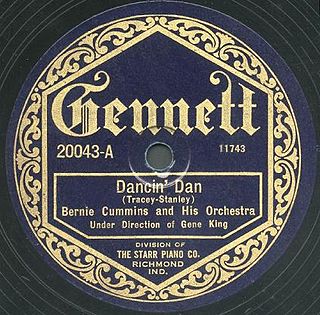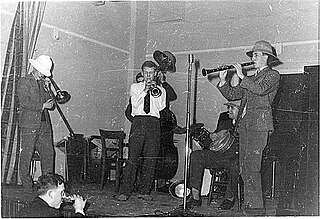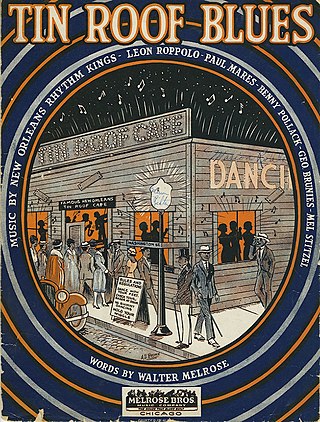Related Research Articles

Ferdinand Joseph LaMothe, known professionally as Jelly Roll Morton, was an American blues and jazz pianist, bandleader, and composer of Louisiana Creole descent. Morton was jazz's first arranger, proving that a genre rooted in improvisation could retain its essential characteristics when notated. His composition "Jelly Roll Blues", published in 1915, was one of the first published jazz compositions. He also claimed to have invented the genre.

Gennett Records was an American record company and label in Richmond, Indiana, United States, which flourished in the 1920s and produced the Gennett, Starr, Champion, Superior, and Van Speaking labels. The company also produced some Supertone, Silvertone, and Challenge records under contract. The firm also pressed, under contract, records for record labels such as Autograph, Rainbow, Hitch, Our Song, and Vaughn. Gennett produced some of the earliest recordings by Louis Armstrong, King Oliver, Bix Beiderbecke, and Hoagy Carmichael. Its roster also included Jelly Roll Morton, Blind Lemon Jefferson, Charley Patton, and Gene Autry.

Barnett, Kyle (2020). Record cultures: the transformation of the U.S. recording industry. Ann Arbor, [Michigan]: University of Michigan Press. p. 42. ISBN 978-0-472-12431-2.
Lester Franklin Melrose was a talent scout who was one of the first American producers of Chicago blues records.

James Price Johnson was an American pianist and composer. A pioneer of stride piano, he was one of the most important pianists in the early era of recording, and like Jelly Roll Morton, one of the key figures in the evolution of ragtime into what was eventually called jazz. Johnson was a major influence on Count Basie, Duke Ellington, Art Tatum, Thelonious Monk, and Fats Waller, who was his student.

Albert Clifton Ammons was an American pianist and player of boogie-woogie, a blues style popular from the late 1930s to the mid-1940s.
General Records was a small American record label during the late 1930s and early 1940s. Its most notable releases are piano solos recorded by Jelly Roll Morton in December 1939 late in his career.
The swing era was the period (1933–1947) when big band swing music was the most popular music in the United States, especially for teenagers. Though this was its most popular period, the music had actually been around since the late 1920s and early 1930s, being played by black bands led by such artists as Duke Ellington, Jimmie Lunceford, Bennie Moten, Cab Calloway, Earl Hines, and Fletcher Henderson, and white bands from the 1920s led by the likes of Jean Goldkette, Russ Morgan and Isham Jones. An early milestone in the era was from "the King of Swing" Benny Goodman's performance at the Palomar Ballroom in Los Angeles on August 21, 1935, bringing the music to the rest of the country. The 1930s also became the era of other great soloists: the tenor saxophonists Coleman Hawkins, Ben Webster and Lester Young; the alto saxophonists Benny Carter and Johnny Hodges; the drummers Chick Webb, Gene Krupa, Jo Jones and Sid Catlett; the pianists Fats Waller and Teddy Wilson; the trumpeters Louis Armstrong, Roy Eldridge, Bunny Berigan, and Rex Stewart.

Bluebird Records is an American record label best known for its low-cost releases, primarily of children's music, blues, jazz and swing in the 1930s and 1940s. Bluebird was founded in 1932 as a lower-priced subsidiary label of RCA Victor. Bluebird was noted for what came to be known as the "Bluebird sound", which influenced rhythm and blues and early rock and roll. It is currently owned by RCA Records parent company Sony Music Entertainment.

Music in the United States underwent many shifts and developments from 1900 to 1940. The country survived both World War I and the Great Depression before entering World War II in December 1941. Americans endured great loss and hardship but found hope and encouragement in music. The genres and styles present during this period were Native American music, blues and gospel, jazz, swing, Cajun and Creole music, and country. The United States also took inspiration from other cultures and parts of the world for her own music. The music of each region differed as much as the people did. The time also produced many notable singers and musicians, including jazz figure Louis Armstrong, blues and jazz singer Mamie Smith, and country singer Jimmie Rodgers.

Trad jazz, short for "traditional jazz", is a form of jazz in the United States and Britain that flourished from the 1930s to 1960s, based on the earlier New Orleans Dixieland jazz style. Prominent English trad jazz musicians such as Chris Barber, Freddy Randall, Acker Bilk, Kenny Ball, Ken Colyer and Monty Sunshine performed a populist repertoire that also included jazz versions of pop songs and nursery rhymes.

Jesse Albert Stone was an American rhythm and blues musician and songwriter whose influence spanned a wide range of genres. He also used the pseudonyms Charles Calhoun and Chuck Calhoun. His best-known composition as Calhoun was "Shake, Rattle and Roll".

Kansas City jazz is a style of jazz that developed in Kansas City, Missouri during the 1920s and 1930s, which marked the transition from the structured big band style to the much more improvisational style of bebop. The hard-swinging, bluesy transition style is bracketed by Count Basie, who in 1929 signed with Bennie Moten's Kansas City Orchestra, and Kansas City native Charlie Parker, who promoted the bebop style in America.
The Red Hot Peppers were a recording jazz band led by Jelly Roll Morton from 1926–1930. They were a seven- or eight-piece band formed in Chicago which recorded for Victor and featured some of the best New Orleans-style freelance musicians available, including cornetist George Mitchell, trombonist Kid Ory, clarinetists Omer Simeon and Johnny Dodds, banjoists Johnny St. Cyr and Bud Scott, double bass player John Lindsay, and drummers Andrew Hilaire and Baby Dodds.

Benjamin Franklin "Reb" Spikes was an American jazz saxophonist and entrepreneur. His composition with his brother John, "Someday Sweetheart", has become an often-recorded jazz standard.

"Original Jelly Roll Blues", usually shortened to and known as "Jelly Roll Blues", is an early jazz fox-trot composed by Jelly Roll Morton. He recorded it first as a piano solo in Richmond, Indiana, in 1924, and then with his Red Hot Peppers in Chicago two years later, titled as it was originally copyrighted: "Original Jelly-Roll Blues". It is referenced by name in the 1917 Shelton Brooks composition "Darktown Strutters' Ball".

"Tin Roof Blues" is a jazz composition by the New Orleans Rhythm Kings first recorded in 1923. It was written by band members Paul Mares, Ben Pollack, Mel Stitzel, George Brunies and Leon Roppolo. The tune has become a jazz standard and is one of the most recorded and often played New Orleans jazz compositions.
Walter Melrose was a music publisher and lyricist in the 1920s and 1930s.

The Smithsonian Collection of Classic Jazz is a six-LP box set released in 1973 by the Smithsonian Institution. Compiled by jazz critic, scholar, and historian Martin Williams, the album included tracks from over a dozen record labels spanning several decades and genres of American jazz, from ragtime and big band to post-bop and free jazz.

125 Jazz Breaks for Trombone is a 1927 folio or songbook of compositions for trombone by Glenn Miller. The jazz breaks were included in a songbook published by the Melrose Brothers in Chicago and a UK edition by Herman Darewski.
References
- ↑ "Frank Melrose (1907-1941)". Red Hot Jazz Archive. 30 August 2020. Retrieved 30 August 2020.